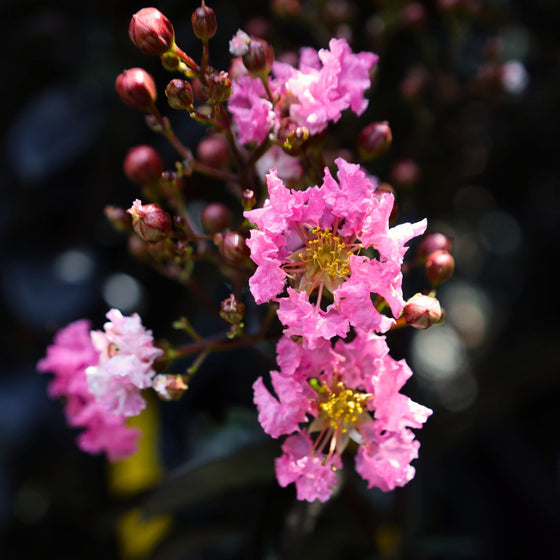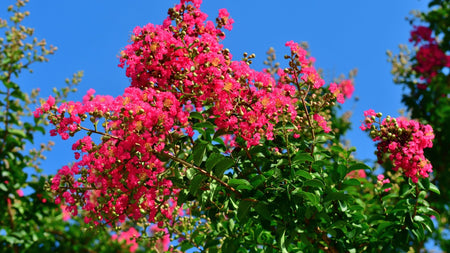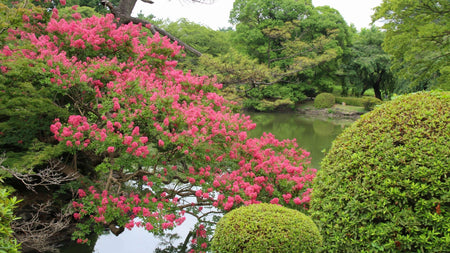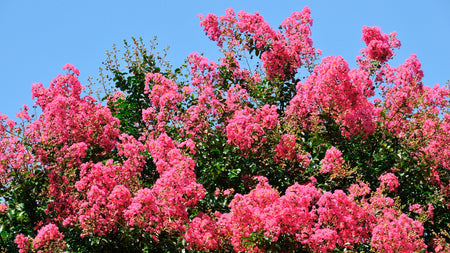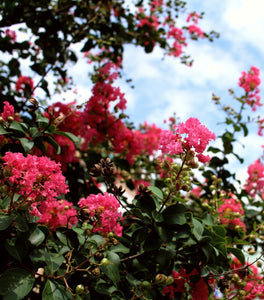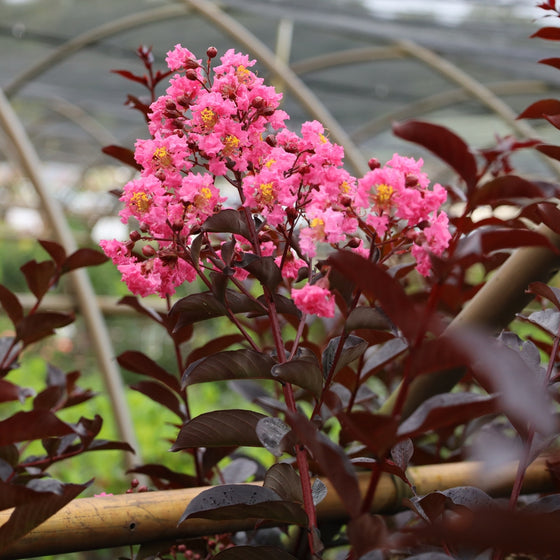
Images Depict Mature Plants
Twilight Magic Crape Myrtle Trees
Twilight Magic™ Crape Myrtle (Lagerstroemia 'PIILAG B5' PP27,194) is a breathtaking ornamental tree known for its dramatic color contrast and long-lasting summer blooms. Featuring rich, deep purple-black foliage that remains striking throughout the growing season, Twilight Magic™ is crowned with vibrant, fuchsia-pink flowers that create an eye-catching display from midsummer into fall. This fast-growing crape myrtle reaches an impressive 16 to 20 feet tall and 8 to 12 feet wide, making it perfect as a colorful focal point, privacy screen, or bold backdrop in sunny landscapes.
Thriving in full sun and well-drained soil, Twilight Magic™ Crape Myrtle is highly resistant to common diseases like powdery mildew and leaf spot, ensuring its gorgeous foliage stays clean and healthy all season long. It is drought-tolerant once established and low maintenance, requiring little more than occasional pruning to maintain its natural shape. Its vivid, dark foliage provides a dramatic contrast not only to its own flowers but also to surrounding plants, making it an outstanding choice for adding depth, color, and year-round visual interest to gardens, urban landscapes, and suburban yards.
Ideal for adding bold color to foundation plantings, mixed borders, and large containers, Twilight Magic™ Crape Myrtle also attracts pollinators like bees and butterflies, supporting a healthy garden ecosystem. Whether used as a single specimen, a grouping for maximum impact, or a flowering privacy hedge, Twilight Magic™ delivers unforgettable beauty with minimal care. Its superior disease resistance, vibrant blooms, and striking foliage make it a standout choice for gardeners seeking high-impact, low-maintenance landscape solutions.

| Hardiness Zone: | 6-9 |
|---|---|
| Mature Height: | 16 to 20 feet |
| Mature Width: | 8 to 12 feet |
| Sunlight: | Full Sun |
| Habit: | Deciduous, densely branched, multi-stemmed summer through the first frost |
| Flower Color: | Fuchsia Pichs |
| Foliage: | New growth emerges a rich reddish purple, eventually turning dark purple almost Black |
| Soil Condition: | Any well drained soil |
| Water Requirements: | Water well until established |
| Uses: | extremely attractive when used as a focal point in the mixed border, mass planting |
How to Care for First Editions® Twilight Magic™ Crape Myrtle
Be sure to read about the recommended care instructions to keep your Twilight Magic Crape Myrtle Trees healthy and thriving for years to come!
How Do I Plant My Twilight Magic Crape Myrtles?
To plant your Twilight Magic Crape Myrtle successfully, select a location that receives full sun for at least six to eight hours a day, as this ensures the richest foliage color and the most abundant blooms. Crape myrtles thrive in well-drained soil, so it’s important to avoid low-lying areas where water can pool. Start by digging a hole twice as wide and just as deep as the root ball, loosening the soil at the bottom to encourage healthy root growth. Carefully place the tree into the hole, making sure the top of the root ball sits level with or slightly above the surrounding soil, then backfill with a mix of native soil and organic compost. Water thoroughly after planting to settle the soil and eliminate air pockets. After planting your Twilight Magic Crape Myrtle, apply a 2–3 inch layer of organic mulch around the base of the tree, keeping it a few inches away from the trunk to prevent rot. Mulching helps conserve soil moisture, regulate temperature, and suppress weeds, especially important during the tree’s establishment period. For best results, water deeply once or twice a week during the first growing season to encourage deep root development. With proper planting and care, your Twilight Magic Crape Myrtle will quickly reward you with its vibrant pink flowers, dark purple-black foliage, and strong disease resistance, making it a standout feature in sunny landscapes.
How do I water My Twilight Magic Crape Myrtles?
Watering your Twilight Magic Crape Myrtles properly is crucial for establishing strong roots and ensuring vibrant blooms and healthy foliage. During the first growing season, water deeply once or twice a week, allowing the soil to dry slightly between waterings to encourage deep root growth. Focus on watering at the base of the plant rather than overhead, which helps prevent fungal diseases and keeps the rich purple-black foliage looking its best. Using a soaker hose or drip irrigation system is ideal, as it delivers slow, consistent moisture directly to the roots where it's needed most. Once established, Twilight Magic Crape Myrtles become highly drought-tolerant and typically require only occasional deep watering during prolonged dry periods. Always check the top few inches of soil—if it feels dry to the touch, it’s time to water thoroughly. Applying a 2–3 inch layer of organic mulch around the base helps conserve moisture, reduce soil temperature fluctuations, and minimize weeds. With consistent, mindful watering practices, your Twilight Magic Crape Myrtles will thrive, producing bold fuchsia-pink blooms and maintaining their dramatic dark foliage throughout the growing season.
When Should I Fertilize My Twilight Magic Crape Myrtle?
You should fertilize your Twilight Magic Crape Myrtle in early spring, just as new growth begins to emerge, to encourage vibrant blooms and lush, healthy foliage. Use a balanced, slow-release fertilizer, such as a 10-10-10 or a fertilizer formulated specifically for flowering trees and shrubs. Apply the fertilizer evenly around the tree’s drip line, taking care to keep it several inches away from the trunk to avoid burning the roots. Water thoroughly after applying to help the nutrients soak into the soil and reach the root system, setting your Twilight Magic up for a season of vigorous growth and bold color. For optimal performance, a second light feeding in mid-summer can be beneficial, especially if the soil is poor or if you want to encourage a longer blooming period. Avoid high-nitrogen fertilizers, as they can promote excessive leafy growth at the expense of flowers. Consistent, moderate fertilization will help your Twilight Magic Crape Myrtle produce abundant fuchsia-pink blooms, maintain its striking purple-black foliage, and enhance its natural disease resistance. With the right fertilization schedule, your crape myrtle will thrive and remain a stunning focal point in your sunny landscape for years to come.

How and When Do I Prune My Twilight Magic Crape Myrtle Tree?
Pruning your Twilight Magic Crape Myrtle Tree correctly helps maintain its elegant shape, encourages abundant flowering, and promotes overall plant health. The best time to prune is in late winter or very early spring before new growth starts to emerge. Begin by removing any dead, damaged, or crossing branches using clean, sharp pruning shears. Focus on lightly thinning the canopy to improve air circulation and sunlight penetration, which helps reduce disease risks and supports vibrant blooming. Always avoid cutting back large branches drastically—a practice known as "crape murder"—which can ruin the tree's natural form and lead to weak, unsightly growth. When pruning your Twilight Magic Crape Myrtle, aim to enhance its natural vase-like shape while keeping the main structure open and airy. Remove any suckers or sprouts from the base of the tree and any small inward-growing branches to maintain a clean, elegant silhouette. Light shaping can also be done after the first flush of blooms to encourage a possible second bloom cycle. Proper annual pruning ensures that your Twilight Magic Crape Myrtle maintains its strong structure, produces bold fuchsia-pink flowers, and showcases its rich purple-black foliage throughout the growing season, making it a true focal point in your sunny landscape.


